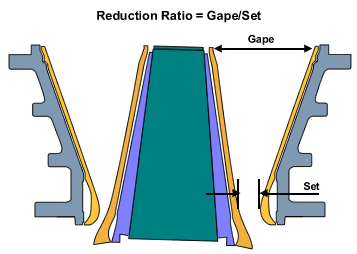 There are Crushing Industry Terms, Vocabulary as well as a number of expressions, peculiar to operation of rock crushing plants, have come into common usage among crusher designers and operators. Inasmuch as these terms are used rather loosely, and with a considerable degree of freedom as to their exact meaning, it is desirable to define a few of the more important ones to make clear the sense in which they will be used in this work.
There are Crushing Industry Terms, Vocabulary as well as a number of expressions, peculiar to operation of rock crushing plants, have come into common usage among crusher designers and operators. Inasmuch as these terms are used rather loosely, and with a considerable degree of freedom as to their exact meaning, it is desirable to define a few of the more important ones to make clear the sense in which they will be used in this work.
Blocking means the blockading of the crusher receiving opening by a piece of rock or ore that is too large to enter the crushing chamber in any position.
Bridging means the blockading of the receiving opening by one or more pieces, any of which are small enough to enter the crushing chamber, but which are prevented from doing so, either because they fall so as to span the opening, or so that they mutually block each other from entrance.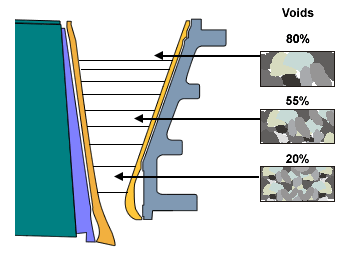
Choking means a complete, or practically complete, stoppage of the downward flow of material in the crushing chamber. It may be the result of an external condition, such as a “backup” of material occasioned by an obstruction in the discharge chute, in which case choking is followed by packing in the crushing chamber. Or choking may be the result of a condition existing within the crushing chamber, such as too close a discharge setting, too many fines in the feed, or sticky material. When so caused, packing precedes and brings about the choke-up.
Choking refers to a stoppage in the downward flow of rock in the crushing chamber. This can happen due to physical blockage from underneath, or when there are too many fines present.
The volume in the crushing cavity decreases with depth in the crusher until the choke zone is reached. Material entering the crusher must contain a certain minimum amount of void space to be largely filled as the material is broken and reaches the choke zone. 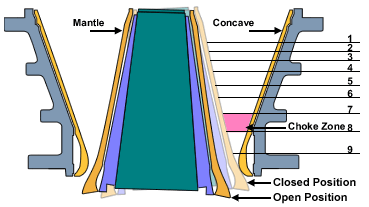 If the voids are filled too soon the material will no longer compress but will instead pack against the walls.
If the voids are filled too soon the material will no longer compress but will instead pack against the walls.
The choke-point in a crushing chamber is that level in the chamber where the capacity of the crusher is a minimum; that is, it is the bottle neck of the crushing chamber. It follows that it is the point where choking is most likely to occur, particularly so if the choke is promoted by a condition existing within the crusher. Note that the existence of a choke-point does not imply that choking will necessarily occur; in fact, as will be explained later, all compression-type crushers have a choke-point at some level within the crushing chamber.
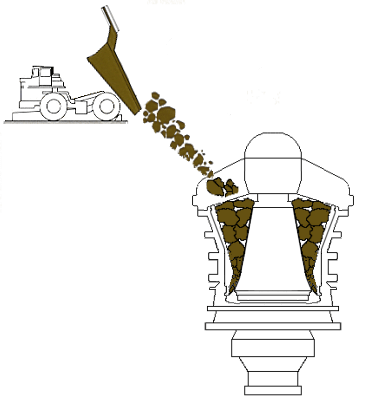 Choke-feed implies a completely filled crushing chamber (or as full as the design will permit), with a sufficient head of material above the receiving opening to keep the crusher full continuously. This contrasts with regulated-feed, which implies that the flow of material to the crusher is throttled to a point somewhat below the capacity of the machine, so that the crusher is never completely filled.
Choke-feed implies a completely filled crushing chamber (or as full as the design will permit), with a sufficient head of material above the receiving opening to keep the crusher full continuously. This contrasts with regulated-feed, which implies that the flow of material to the crusher is throttled to a point somewhat below the capacity of the machine, so that the crusher is never completely filled.
A gyratory crusher is choke fed when the chamber is full and there is material above to keep it full. This contrasts with regulated feed, where the flow of material to the crusher is throttled in some manner so that the crusher is never completely filled. A crusher is choke fed to:
- Counteract slippage by maintaining a weight on top of the rock in the crusher.
- Promote crushing of particles by other particles. This reduces wear on mantle and concaves, produces more fines (finished product), and increases the effective reduction ratio.
- Even out the power demand.
- Maximize the machine’s capacity
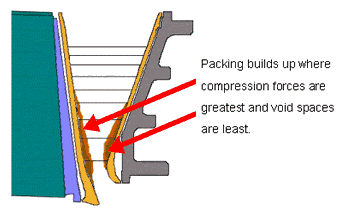 Packing refers to a compacted or compressed condition of the material in the crusher, characterized by a complete or nearly complete absence of voids. Any condition which tends to retard the free movement of material downward through the crushing chamber tends likewise to promote packing. Packing also is used to describe the building up of fine, sticky material on the diaphragm of a gyratory crusher, or the discharge chute below any type of crusher.
Packing refers to a compacted or compressed condition of the material in the crusher, characterized by a complete or nearly complete absence of voids. Any condition which tends to retard the free movement of material downward through the crushing chamber tends likewise to promote packing. Packing also is used to describe the building up of fine, sticky material on the diaphragm of a gyratory crusher, or the discharge chute below any type of crusher.
Packing refers to a condition in the crusher where the material is compacted against the mantle and/or concaves that results in a significant reduction in throughput. Any condition that tends to retard the free flow of material through the crusher can lead to packing. When the feed is too wet it will not flow as freely. The excessive use of dust sprays, or natural moisture containing materials such as clay, will promote packing. The operational factor most responsible for packing is the presence of wet fines. The more fines there are the less voids are available. When the feed contains too much wet fines the crusher should not be choke fed
Ratio-of-reduction is a term that refers to the size of the largest cube that the crusher will receive, divided by the size of the largest cube that it will discharge. Actually, we are not dealing with exact cubes when we crush rock or ore; therefore it is more convenient, at least when discussing crushers of the compression family, to base the ratio-of-reduction upon the dimensions of the crushing chamber.
The Reduction Ratio is the ratio of the largest feed size that a crusher will accept (called gape) and the largest product size it will discharge (called set). Among the factors that influence the reduction ratio are:
- the amount of rock in the crusher
- the percentage of voids
- the toughness of the rock
- the angle of inclination of the crushing surfaces
- the speed at which the unit operates
In crushers of the jaw and gyratory types the ratio-of-reduction is taken to mean the ratio”of the receiving opening (measured from the top of the movable member to the top of the stationary member), to the discharge opening, which may be “open side” or “close side,” depending upon the type of crusher. For crushing rolls, either single or double, the ratio-of-reduction is the ratio of the greatest dimension that the machine will nip, to the dimension of the discharge setting.
The hammermill is not quite so easily gauged, because of the wide disparity in the size of product possible with any one grate-bar spacing. The only fair basis of comparison with other types, therefore, is to base the ratio upon the size of the largest cube that the mill will receive, divided by the size of the product, this product to be gauged by the same standards of screen analysis that are commonly used to judge the products of the other types.

